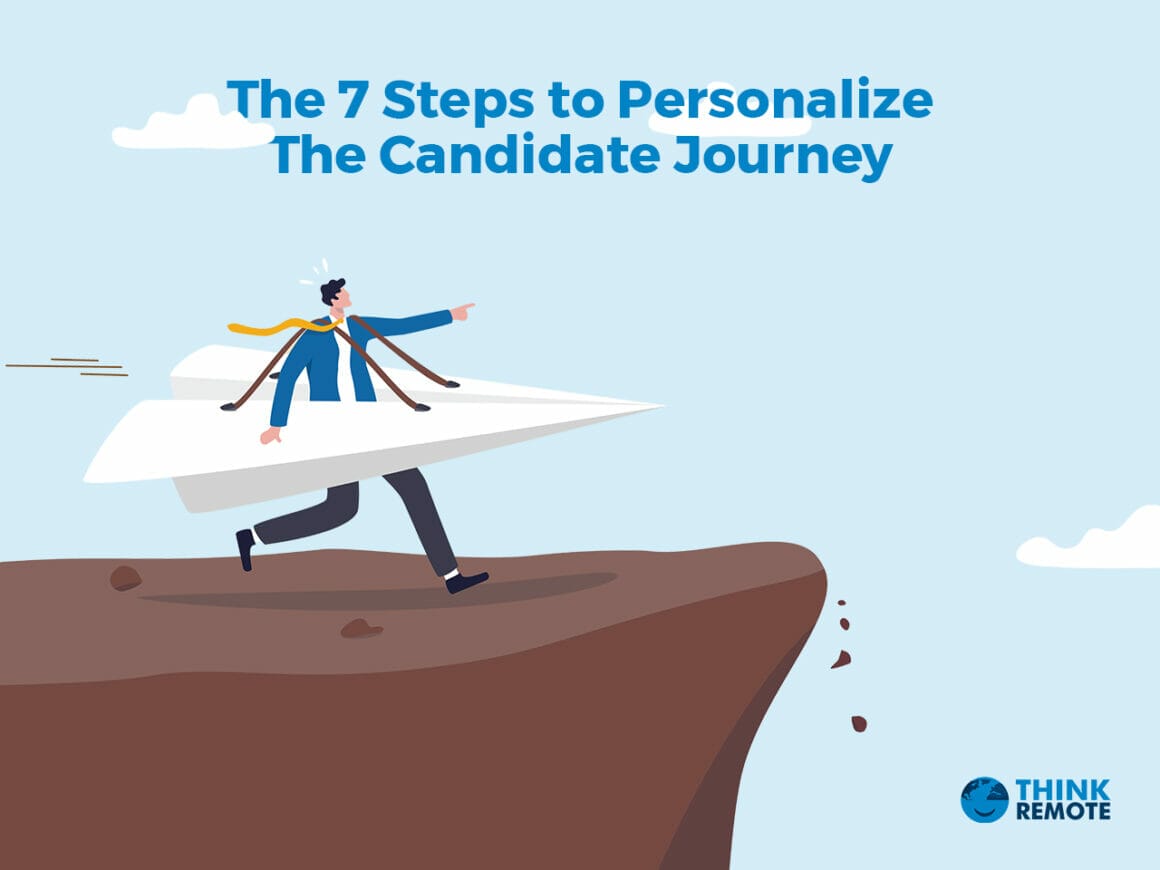Job-hunting can be a rather tiresome process, even for those with years of experience and relevant skills. Plus, the inefficient hiring process of companies doesn’t work in favor of job-seekers. However, offering a smooth candidate journey is one of the best ways to attract more job applications and generate candidate interest.
Candidates go through various steps in the hiring journey before even deciding to apply to a particular job. As a matter of fact, only when they’ve applied, the second phase of their customer journey begins. So, how to make the process more efficient and engaging for them?
What is a Candidate Journey?
The candidate journey is any and every experience a job-seeker goes through while trying to get placed. From learning about the job opening through different platforms to applying for the position, and interviewing, everything is considered a part of the candidate’s journey.
For an organization, it is essential to develop excellent candidate journey touchpoints to attract the best talent across departments.
7 Steps to Personalize The Candidate Journey
1. Ensure The Process is Candidate-Centric
As an organization, you must strive to make the hiring process streamlined and candidate-centric. Applying for a job and not even receiving an acknowledgment regarding the candidate application is a major problem most candidates face .
Not only is it confusing for the candidates but it is also frustrating to indefinitely wait for a reply from the employers. A candidate is less likely to want to work for an organization that doesn’t respect their time.
Word-of-mouth referrals are important for the image-building of any company among skilled job seekers. Most of the hirings in an organization are done through this channel as it is dependable, less time-consuming, and easy.
For word-of-mouth referrals to be positive, companies must focus on making the hiring process candidate-centric. Making it easy for candidates to be updated regarding new openings in your organization and mentioning the steps involved in hiring can help pique a candidate’s interest.
Get rid of lengthy job application forms that would take someone hours to fill. Keeping it short and concise is the way to go to ensure a pleasant candidate journey.
2. Ask For Personal Stories
We all like to be heard. Hearing what someone says without interrupting them is a rare characteristic in today’s fast-paced world. Employees are no different. In fact, with non-streamlined and poorly-planned hiring processes, employees feel that they are not being valued and that their opinions are not being heard.
If you wish to improve the hiring process and attract more candidates for future openings, you need to hear what the employees, or candidates, have to say.
Asking for their personal stories, like past employment experiences, educational qualifications, certifications, ambitions, and professional goals, is a good way to establish a relationship with the candidate and begin the interview on a good note.
While asking such questions, it is important to not cross boundaries and ask questions only professionally relevant.
Some candidates, despite being experienced and exceptionally talented, can be shy or nervous during interviews. Asking about their personal stories can help them ease the conversation and gain confidence.
You can better evaluate a candidate’s potential when they are comfortable and able to give their best.
3. Map Your Ideal Candidate Journey
Having any plan is better than just freeballing it. Planning is integral for pursuing anything of value. By thinking, analyzing, and interpreting targets and methods of achieving them, you significantly improve the success rate.
To ensure a pleasant hiring journey, you must first understand what your ideal candidate looks like. Sit down with your talent procurement team and create a candidate mapping for your ideal applicant.
Listing down the qualities, educational qualifications, personality traits, and work experience you are looking for in a candidate for a particular role is the first step towards developing a candidate journey map for the perfect job-seeker.
Deciding the channel through which you would be listing job openings is another important aspect of curating the candidate´s journey. Your organization’s official website, email campaigns, social media posts, and third-party hiring websites are all ideal channels through which you can list jobs.
Use data and analytics from the past to figure out which channels work best for you. Deciding the frequency and method of employee communication your organization will engage with shortlisted candidates is pivotal. Sending updates regarding their job application shows the candidates that your organization respects their time and takes their job applications very seriously.
4. Make it Easy To Join Your Talent Community
An applicant should not have to follow up several times just to find out if an organization has considered their application. Uncertain wait time creates negative connotations toward the employer in the candidate’s mind.
The candidate journey begins when a potential employee is exposed to your brand. Everything from how descriptive the job title is to how it is presented affects how a candidate perceives your brand.
Another significant roadblock that candidates face while trying to apply for a job is the confusing and often tiring application process. The job application process needs to be simple, short, and easy.
Avoiding generic questions, the answers to which is already likely to be mentioned in the applicant’s résumé, is a great idea for making the candidate application process short.
Using newsletter campaigns to update interested candidates regarding new openings, virtual interviews for shortlisting candidates before calling them for personal interviews, and prompt communication between the talent acquisition team and the candidates are all ways to make it easy for interested professionals to join your talent community.
5. Encourage candidates to provide feedback on the interview procedure
Those who do not learn from their mistakes are bound to repeat the same mistakes. One of the best ways to get feedback on the candidate journey your organization offers is to ask for feedback from the candidates themselves.
It is as simple as that. All you need is an open mind and a willingness to listen to address your shortcomings. As an organization, encourage your candidates to share their honest experiences of applying for a job.
Encourage them to be as descriptive as possible and guide you through the difficulties they might have faced during each step of the hiring process.
You do not have to necessarily ask for only areas where you can improve. You should encourage the candidates to speak about the positive experiences and the takeaways of applying for a position at your organization. This will help you understand what is working right and you can further build upon that.
6. Be Selective
Being selective sounds simple, doesn’t it? If the corporate world, however, keeping things simple is somehow the toughest thing to do.
Being selective is a simple and effective way of personalizing the candidate journey. Here, “being selective” means prioritizing the relationship you build with the candidate rather than just looking at their résumé. After all, people aren’t best judged on paper, but in person.
While building a relationship or rapport with a candidate, you can best gauge if that person is suitable for the position you are looking to fill, whether the person can thrive in the work environment of your organization, and if they will enhance synergy by successfully working with different departments.
Being selective about the kind of personality your candidate has rather than just looking at past experiences and educational qualifications is a great way to guarantee a successful hiring process.
7. Prepare an Onboarding Process
Onboarding is the final step in your hiring process. As far as candidates are concerned, a smooth onboarding process is pivotal for them to blend into your company’s workforce without feeling alienated.
Organizations that do not offer a good onboarding experience to the new employees tend to suffer from an increased employee turnover rate. The first few weeks at work are the toughest for new employees, especially when there is a lack of communication.
A welcome email to the new employees, introducing them to their reporting manager and peers, goes a long way in helping them get settled in and deal with anxiety.
Most employees also find it helpful to have a personal meeting with their reporting managers on the first day of work. Such small albeit positive interactions often has a positive impact on the employee’s morale.
Ready to Receive Your Next Candidate?
Ensuring an ideal candidate journey is beneficial for both parties. If you follow the points mentioned above in this blog, you can significantly improve and personalize the candidate maps and journey. However, you do not have to limit your efforts to just these tips and can use your own tricks and techniques to improve the hiring process.
Conducting quarterly meetings or brainstorming sessions with the talent acquisition team develop new ideas for improving the hiring journey is highly recommended.
There is no fixed approach to improving your hiring process and candidate journey recruitment. It is important to remember that there is always scope for improvement and that being open to constructive feedback from your employees and job applicants is vastly helpful.
FAQs
There are various aspects involved in a candidate journey. Generating interest among potential candidates even before they apply for a position at your organization is one of the first steps toward creating a positive candidate journey. A smooth interview and onboarding process are also vital aspects that make the candidate journey more personalized for the applicant. Listing down the qualities you are looking for in an employee is helpful when looking to fill in a position at your organization. The recruitment team can further reflect upon and improve the candidate journey of an organization by acquiring genuine feedback from candidates and employees.
Defining a task makes it easier to achieve it as you have clear guidelines to adhere to. One of the most important steps toward mapping candidate journey is to define the persona you are looking to hire. Take into consideration your organization’s work culture and pace of work while defining the kind of personality your ideal employee should have.
Setting up the candidate journey framework, defining all the stages a candidate goes through before being placed in your organization, is helpful for mapping candidate journey. Defining clear communication targets for keeping the candidate in the loop is essential. Without communication or updates from the organization, the candidate tends to feel left out.
While the first stage is obviously to create awareness among candidates regarding your organization, onboarding is the final stage of the candidate journey.
Through various mediums, the talent acquisition teams try to generate interest among potential candidates. A large number of candidates must apply for a position so that you can find the best possible employee for your organization. Although all the steps are important, the first and the last steps, creating awareness and onboarding, are crucial to ensure an impressive candidate journey.






